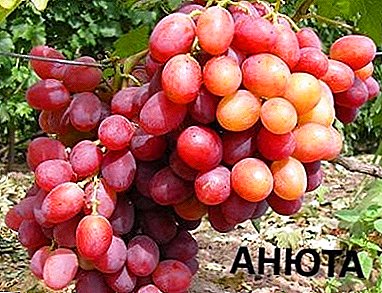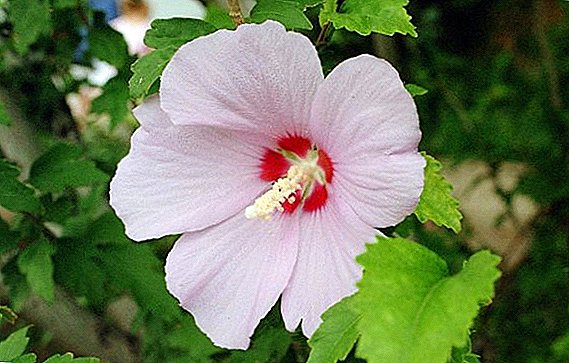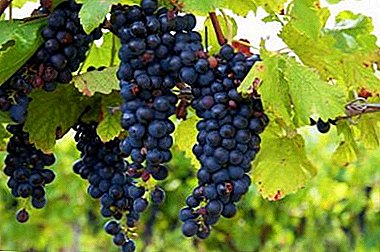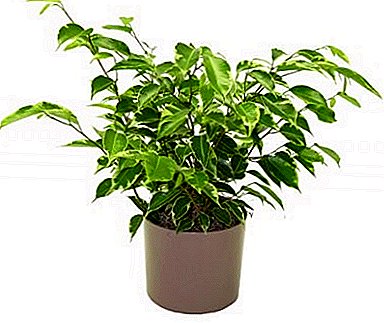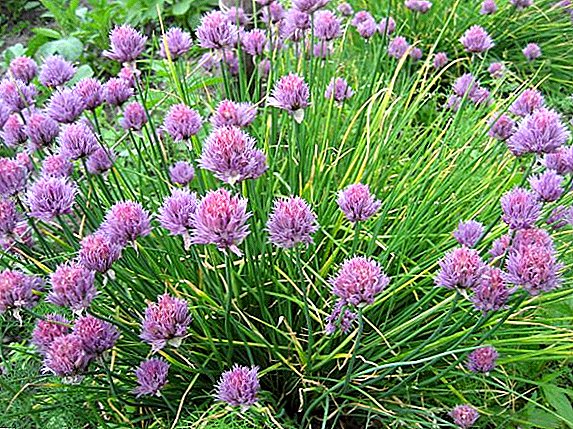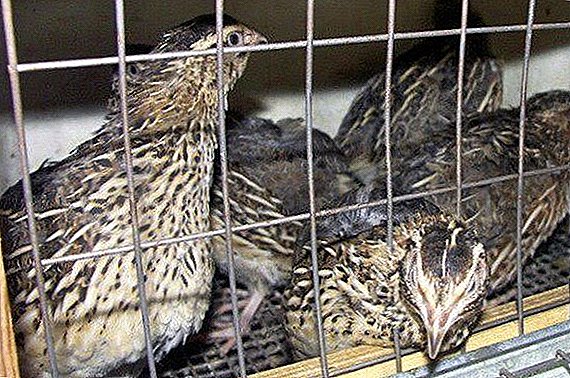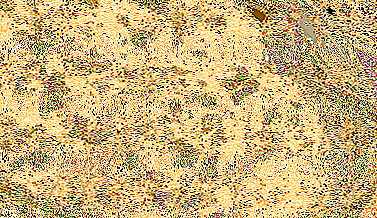
Often gardeners, gardeners and just lovers of indoor plants face various problems.
The cause of some of them is pest aphid. What is this insect and what it is, you will learn in our article.
In the article we will consider the main types of aphids, show photos, analyze their differences between themselves.
About insect
Aphids - insects the size of a few millimeters. Special proboscis they pierce the leaves and shoots of plants, causing them harm. There are wingless and winged species. The first provide reproduction, and the second - distributors.
They appear in spring from the larvae that hatch from the egg. She feeds on the sap of a young plant and starts breeding white-winged females.
Species and their photos
Gourd
It harms only agricultural crops - cucumbers, tomatoes, watermelons, etc. The color varies from yellow to different shades of green. Body oval up to 1.2 - 2 mm. Sucks the sap from the plant, making them weak and vulnerable. Foliage spoils, fruits become smaller, their taste deteriorates.
To control the need to remove the weeds from the site, treat the plants with an insecticide solution.

Big cereal
The body is greenish and red tinged and 2.5 - 3.2 mm long. It has cylindrical, long and black juice tubes. Eggs are shiny, black, oblong.
Sharply their numbers increase during the earing-flowering period. Cereal leaves fade and die. The plant infected before the earing does not form an ear, if later, it will be short, the number of grains in the ear will decrease.
To combat the complex use of biological, agrochemical and agrotechnical plant protection products.

Cherry
It hurts cherries and cherries. The length of the body is 2.4 mm and has a wide pear shape, shiny black on top and brown on the bottom. The tubules are black, cylindrical. Eggs are shiny and black. Suck the juice from the underside of the leaves. His growth stops, he shrinks. Damaged shoots do not grow, the leaves turn black and fall away.
Methods of struggle:
- cutting and destruction of areas where aphids develop and often hibernate;
- clearing the tree of dead bark;
- early spraying with mineral oil preparations;
- insecticide treatment.

Gallic
Pest of currant red and white currant. Insect ovoid, body 2 - 2.3 mm. The body is transparent pale, greenish-yellow hue. There are small hairs. Sucks plant sap, depletes shoots. Lives on the branches until they are completely withered. Attracts other insects (ants), which also feed on the sap of the plant’s berries and contribute to its distribution. The carrier of pathogens of viral infections of plants.
For prophylaxis - sprayed with a solution of nitrafen, destroy weeds.
To combat - use a mechanical method (removal of shoots in pests) and a biochemical method (insecticide spraying).

More information about the fight against aphids on currants can be found in this material.
Pea
Pest of pea, alfalfa, sainfoin. Body length 4 - 6 mm. Eggs are black, shiny and elongated. Color from green to brownish red. They have long antennae and thin green tubes one third of the body. It is a carrier of viruses. Reduces yield.
For treatment - spraying with neonicotinoids, pyrethroids, organophosphorus compounds.

Green
Dangerous for fruit, berry and some forest plants (apple, pear, quince, hawthorn, mountain ash, loquat, cotoneaster). Wingless insect is yellowish-green or brownish-yellow. Body length 1.6 mm. The tubules and tail are black. Antennae consist of six segments.
In the fight used:
- cutting infected areas;
- spraying crowns and booms with insecticides and biological pesticides.

Cereal
Prefers barley, oats, winter and spring wheat, millet, rice, sorghum. Eggs are light green, later black and shiny. Size 0.6 mm, oval. Wingless females, males vice versa. Length up to 2.2 mm. Long antennae. In the female, the spindle-shaped body, in the male, is thin, slightly curved.
It feeds on the elevated parts of the plant. Severe infection leads to the death of the plant. Degrades grain quality, reduces yields.
Use spraying pyrethroids, organophosphates, neonicotinoids and other insecticides.

Cabbage
Damages radish, canola, cabbage. Enters the plant enzymes, suck the juice. It reduces the amount of chlorophyll, sugar and vitamins. The leaves turn yellow and dry, development stops, seeds do not form on the mother plants.
In order to avoid infection, weeds are removed in a timely manner, autumn plowing of fields is carried out. Infected plants are sprayed with insecticides.

Root
Eggs are oval-shaped and black. Color yellow and green shades. The body is covered with fine hairs and wax coating. Pear shaped body up to 2.6 mm. The legs and antennae are dark brown in color. Eyes red or black. It feeds on the underground parts of the plant, the fibrous and thin lateral roots. Damage will lead to drying of the fruit, leaves and the whole plant.
Fight harvesting root crops and plant residues, plowing the ground, adding wood ash to the wells when planting. Treat infected roots with biological products..

Cochineal
Females stick to the plant and suck the juice out of it. Never moves. It lives on the roots of grasses and herbaceous plants. Used by man to obtain carmine dye due to coloring matter.

Red
It affects apple and other fruit. Body length not more than 1.1 mm. Form ovoid, slightly pubescent. The color is bright orange. Proboscis no. Black eyes. Paws and antennae white. It settles on young shoots at the base of the kidneys, on the stalks of leaves, on the stalks.
As a result, knotty seals form on the plant, which later crack, leaving deep ulcers into which putrefactive bacteria get and the plant dies.
It is necessary to loosen the soil and carefully choose a place for planting.
Treatment - spraying crowns and boles and the soil under the trees pyrethroids, organophosphates, neonicotinoids, mineral oils, insecticides based on nicotine.

Krasnogallovaya
Body length not more than 2.4 mm, round shape, lemon yellow color. In winged individuals, the head and chest are gray-brown. Harm red, white and black currants, as well as apple. Causes changes in tissues. From this red blooms appear, the plant produces poor fruit, the leaves fall off and the plant can die.
Prevention - the destruction of weeds and ants, trapping belts in trees, clearing tree trunks from dry bark, the attraction of ladybirds and gold-eyed. The infected plant is treated with insecticides.

Corn
It is a carrier of maize mosaic virus. Inhabits winter and spring crops in the axils of the upper leaves. It has an elongated, oval, pollinated body of gray-green color. Legs, antennae and head in black, short tubes.
For treatment:
- remove infected areas;
- process chemicals;
- attract beneficial insects, such as ladybugs, to fight the pest (more about ladybirds and how to attract them can be found here).

Peach
Harmful to vegetable, green, flower-decorative and fruit crops.. It feeds on the sap of the plant, sucks the life force out of it The plant dies. Body length 2 -2.5 mm. Yellow green, light green and pinkish color. The eyes are brown-red. The tubules are cylindrical and widened at the base. Finger-shaped tail, yellow.
For the fight using beneficial insects and yellow glue traps.

Beet leaf
Harm beet crops. Sears and destroys leaf tissue. Food places turn brown and dry up. Damaged leaves are covered with a sticky coating, which leads to the development of mold. Mosaic Virus and Jaundice Virus. Body up to 2 mm. Dark green or black. It has short antennae. Legs are lighter in color.
Urgent treatment with insecticides and removal of damaged areas of the plant is necessary.

Black
Damages cucumbers and tomatoes. Insect up to 5 mm long. Color - blue, brown, green, black. The stem and leaves are covered with black dots. The leaves turn yellow and deform, brown spots appear.
There are such methods of struggle:
- biological (removal of infected parts, planning holes for planting, attracting beneficial insects);
- biological treatment;
- chemical treatment.

Sadovaya
It feeds on fruit trees, bulbous flowers. Body wide oval 2-3 mm. Color from dark gray to olive green. Covered with a powdery coating.
Get rid of garden aphids:
- mechanically - to collect hands or knock off a stream of water;
- using beneficial insects;
- carried out prevention.

Flying
It is a form of adult insects, namely females. Does it fly or not? She is able to fly from one plant to another and lay eggs on them. Thus infecting more and more plants.

It is best to carry out preventive measures to prevent contamination of plants. And if the plant is already infected, then treat it in its early stages.
- How to get rid of aphids on orchids at home?
- How to get rid of aphids on pepper?
- What to do if aphid started up on roses?
- How is the struggle with aphids on fruit trees?
- Fighting green apple lice and its other species.
- How to deal with pest on cucumbers?
- How to deal with aphids on indoor plants and win?
- How to deal with white aphids on indoor and garden plants?
- How to get rid of aphids in the garden?
Aphids are the most common insect pest that gardeners encounter.. As a result of the work, the three plants perish. Therefore, be attentive to your green pets, pay more attention to them, inspect for the presence of pests and carry out preventive measures. Then you will not face the problem of the appearance of aphids.


